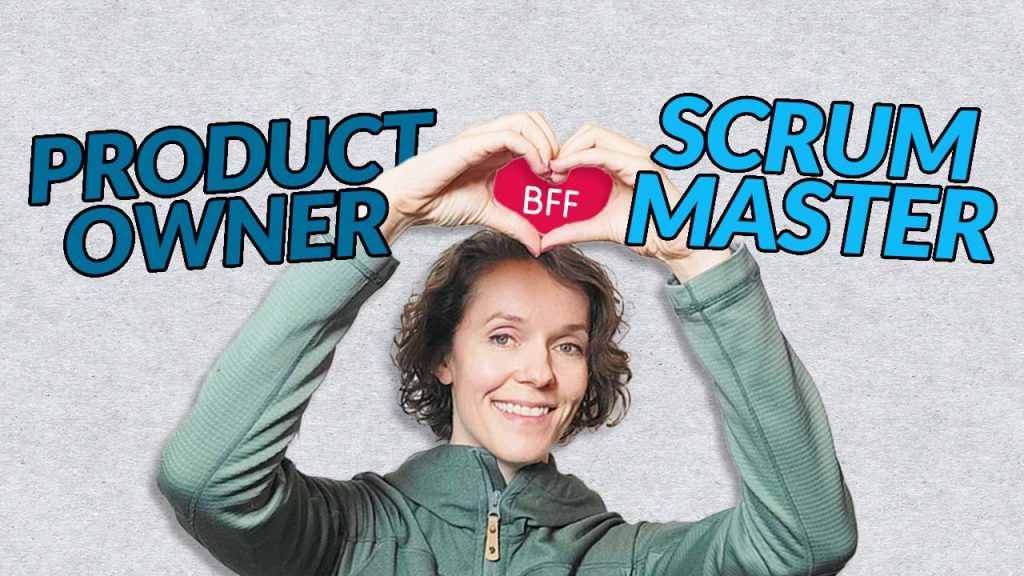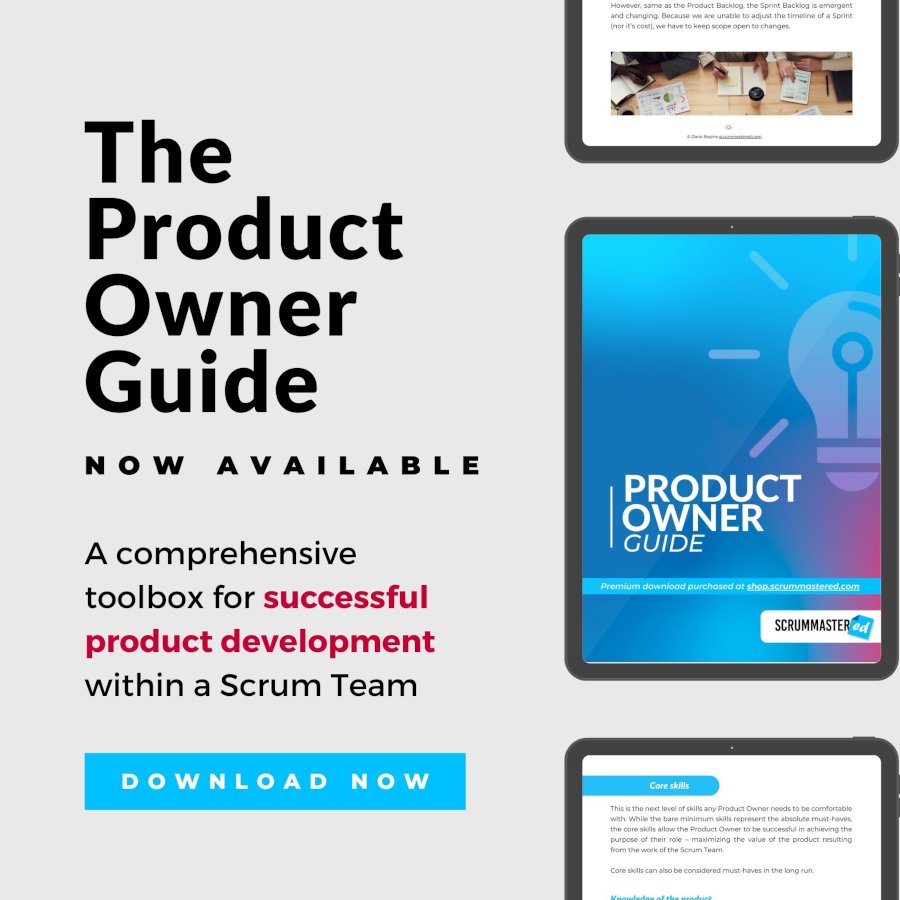Are you a Scrum Master? Then the Product Owner is your best friend.
Are you a Product Owner? Well, then the Scrum Master is your best friend!
It might seem a bit dramatic, but if you take it that way your Scrum Team is only going to benefit from it.
Watch this video (or keep reading) to find out why Scrum Master and Product Owner need to work together as one team and how to achieve this idealistic view.
Scrum Master and Product Owner are part of one team and the best results can be achieved when both of them work together to support the team.
Let me give you the cringiest but very relevant analogy: as two parents need to team up and be on the same page when raising children the Scrum Master and Product Owner need to do the same.
Just before you guys get annoyed – I don’t mean that Developers are children! Far from it. It’s just an analogy to get my point across.
I took this analogy for a very specific reason.
Often the roles of the Scrum Master and the Product Owner almost seem to be in constant conflict where the Product Owner is the bad guy pushing the team to their limits while the Scrum Master is there to protect them.
Or the other way around where the Scrum Master keeps interrupting the team with processes and practices while the Product Owner just tries to get a product delivered.
If you look at the two roles as if they were parents, that kind of dynamic seems toxic. So it’s a no-no.
Ok, let’s put that cringy analogy aside and look at its practical and professional application instead.
But before I jump into the rest of the video, a quick reminder to subscribe to the channel and like this video.
And check out my online store for some guides and templates for building awesome teams.
Product Owner is part of the team

A very common misconception that makes it difficult to build a strong connection between the two roles is the belief that the Product Owner is not actually part of the Scrum Team and instead just someone who works with the team.
That often results in the Product Owner being left out of certain discussions, and even Sprint Events.
The biggest offender here is the Sprint Retrospective.
So many teams and Scrum Masters decide not to invite their PO to the retro. It almost seems to them like inviting a manager.
(that’s actually one of the common challenges with the role of the PO which I’ll talk about later)
Well, that’s not the right way to go.
The Scrum Team consists of three roles: Developers, Scrum Master, AND Product Owner.
The Product Owner IS part of the team and has to be treated that way.
They need to be involved in all relevant Scrum Events and participate on the same level as everyone else.
Everything you need to start a new product delivery
A new practical guide for the role of a Product Owner with all the tools and practices needed to be successful working within a Scrum Team.
Perfect for new Product Owners and Scrum Masters who want to help their Product Owners grow!
Being on the same page with your Product Owner
The next big misconception is that weird sense of conflict between the two roles.
Naturally, all three roles in Scrum are created in such a way to create tension: each role will have a certain priority in mind that might be conflicting with that of other roles.
The reason for that is simple – this allows the team to consider various perspectives and come up with the most optimal solution in the given situation.
Watch my video on conflict in teams to find out more about why this matters and how to manage it.
Anyway… while the disagreements in approaches will happen, eventually, both the Product Owner and the Scrum Master need to come to an alignment around how to work with the team.
For example, if the Scrum Master in encouraging the team to use story points for estimation, that would NOT be ok for a Product Owner to actively push back on it and ask the team to estimate in hours instead.
This would just create a confusion and disarray in the team, and will also lead to a loss of trust and respect towards PO and SM.

That is why it is imperative for the two roles to align on questions like these.
This can become especially helpful when you want to convince the team to use a certain practices – the Product Owner and the Scrum Master can support each other and bring more weight into a debate.
The most important point to keep in mind is that the Product Owner and the Scrum Master work towards the same goals, not against each other, so they better work together to achieve them.
Ok, we talked about the ideal state of where we want the two roles to go. But to be honest – it’s not always that simple.
There are some common challenges you might be facing. So let’s address them.
Common challenges
Challenge number 1: Product Owner is the Team Lead.
A very common way to organize Scrum Teams is to many the Product Owner the team’s manager.
Or the other way around – a Team Lead becomes the Product Owner.
That may pose some problems.
More specifically, it gives the PO WAY too much power over the team’s decision EVEN if the PO doesn’t mean it.
Just the fact that there is a hierarchy will make the team sometimes say ‘Yes’ to things they don’t think are possible, leading to overcommitment and unrealistic expectations.
This may also make the disagreements between the Product Owner and the Scrum Master worse. It may become a power struggle.
(I’ll talk about it more just in a bit)
If you found yourself in a situaton like this, you need to have a serious conversation with your PO about how they position in the organization may negatively impact the success of the team.
This all comes down to them acting more as a servant leader rather than a manager and be mindful of the power they have over the team whether they want to use it or not.
Challenge number 2: Absent Product Owner.
Another common challenge is a Product Owner who is never there.
This may be the case, for example, if the PO role is just an additional part of someone’s job.
Another reason may be because the person assigned to a Product Owner actually doesn’t want to do that job.
In this case the organization may feel that everything is going well because they have a dedicated PO, but the team feels lost and frustrated, because from their point of view – they don’t have a Product Owner.
It’s imperative to make the problem visible as soon as possible.
You can even use metrics that can help you bring transparency to the issue. For example: how long on average does it take to get a reply on a Product Backlog question? How many hours the Product Owner spends to actively work with the team whether it’s in Scrum Events, like Planning, or just in a conversation
The Product Owner needs to communicate with the team on a daily basis. Daily!
If you don’t see it happening, it’s an impediment to the team’s progress.
Challenge number 3: Product Owner is the Scrum Master.
Here I don’t mean the Product Owner is also officially named to be the Scrum Master.
But it’s when a team may well have a Scrum Master, however, the Product Owner takes on decisions and responsibilities of a Scrum Master, stepping on their toes, and not allowing them to do their job.
Some Scrum Masters feel that they need to convince their Product Owner in some of their decisions, check with the Product Owner pretty much every step, or Scrum Masters who struggle with damaging practices implemented by the Product Owner that make no sense to the team.
Solution?
Know what your accountability is and what decisions are yours to take and act on it.
Your Product Owner may disagree, but that’s not up to them to decide on these topics. Same as it’s not your decision what goes into the Product Backlog.
Set those boundaries clear and stop asking for permission to do your job.
In the end, all of these challenges come down to one biggest challenge of them all:
The role of the Product Owner is poorly defined and unclear
As all roads lead to Rome, all Product Owner related challenges usually come out of this one issue – the Product Owner role is misunderstood.
Yes, I often say that the role of the Scrum Master is very misunderstood. But, unfortunately, other elements of Scrum didn’t avoid the same fate.
And to be able to fully support your Product Owner and to work with them as a team, you need to address this misunderstanding first.
Here are a few solutions that can help you along the way:
Teach Scrum.
If Scrum is misunderstood, then your first step is to make it clear.
Help others understand every role in Scrum and put esepcial focus on the role of the Product Owner in this case.
Discuss what long-term impacts the organization will see if the Product Owner is not fulfilling their purpose as it is expected in Scrum.
If you are looking for a good Introduction to Scrum workshop to run for your team, check out my template in the store.
Bring in useful practices.
Apart from teaching Scrum theory, help your Product Owner be more successful with popular product related practices.
Things like product vision elevator pitch, user story mapping, lean canvas, and more.
Not only it is a great way to make clear steps towards better product, but it’s also a great way to engage the whole team in the discussions and decision process.
Work with stakeholders.
And of course, remember your stakeholders. They care about the success of the product, and hence, the success of your Scrum Team, a LOT.
And I don’t mean just teaching them Scrum.
Look at how closely your team works with the stakeholders and whether they need to be more involved.
Are they attending your Sprint Reviews? Do they participate in prioritization workshops? Do they know what Definition of Done is for your product?
These are the key points I wanted to make in this video.
Now, as I promised, let me share an exciting special offer with you.
As you might have heard me talk about it a few times, I’m working on a New Product Owner Guide. It’s a big, very comprehensive guide for the role. I think it may be even more detailed than the Scrum Master Startup Guide.
Anyway, I’ve finished a big part of the guide that already has wealth of useful and actionable information that I want to share with you.
That’s why I’m making the guide available for purchase in my store with a whooping 50% discount!
While it’s not fully finished, there are already over 50 pages ready and I’m adding new stuff every week.
Buying the guide now is the best way to support me AND make sure that it get’s finished even faster!
I’ll put all the links to the guide in the description below as usual.
Let’s summarize what we covered in this video:
- Product Owner is part of the Scrum Team, same as the Scrum Master and Developers.
- The Scrum Master and the Product Owner need to work as a team and be aligned on what practices to use and processes to follow.
- The three common challenges that we see with the Product Owners are:
- The Product Owner is the Team Lead which gives them too much power over the team’s decisions.
- The Product Owner is absent which slows down team progress and creates a lot of frustration.
- The Product Owner steps over the Scrum Master role.
- The biggest reason for all of these challenges is usually that the role of the Product Owner is misunderstood and unclear.
- As a Scrum Master you can help resolve that by teaching Scrum, bringing in useful practices, and working closely with stakeholders.
Check the New Product Owner Guide and other guides and templates in my store.




